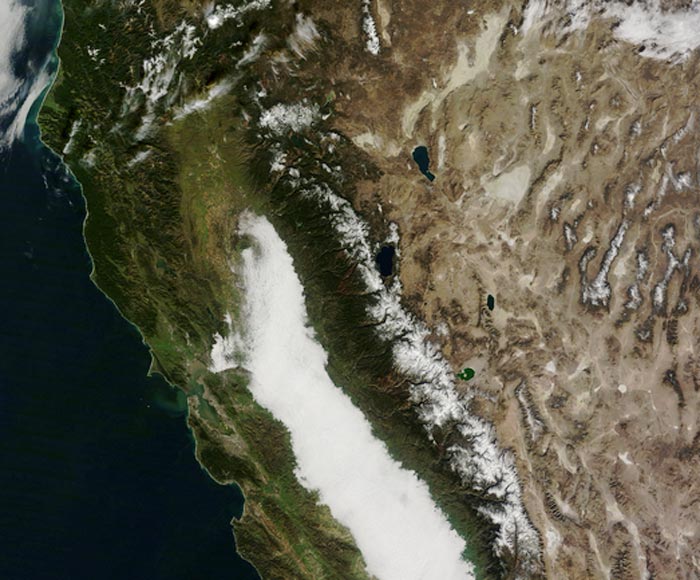The lightness of water vapor adds heft to global climate models

Clouds form over the California coast in 2002.
Credit: Jacques Descloitres, NASA/GSFC
Climate models without the lightness of water vapor risk uncertainty in cloud simulations.
Clouds are notoriously hard to pin down, especially in climate science.
A study from the University of California, Davis, and published in the journal Nature Geoscience shows that air temperature and cloud cover are strongly influenced by the buoyancy effect of water vapor, an effect currently neglected in some leading global climate models.
Global climate models are the primary tools used to study Earth’s climate, predict its future changes and inform climate policymaking. However, climate models often differ on the precise degree of future warming, largely due to their representation of clouds.
“Climate models are the best tool we have to predict future climate change,” said lead author Da Yang, an assistant professor of atmospheric science at UC Davis and faculty scientist at Lawrence Berkeley National Lab. “It’s important that we actively try to improve them.”
Cold air rises?
While conventional wisdom has it that hot air rises, the reverse is true in the tropical atmosphere, the study notes. Previous research by Yang and his colleagues proposed that cold air rises in the tropics because humid air is lighter than dry air. This effect is known as vapor buoyancy, and it regulates the amount of low clouds over the subtropical ocean.
“Vapor buoyancy influences the distribution of low clouds—the kind of clouds we have off the California coast, which contribute greatly to the global energy balance,” said Yang. “The biggest challenge in accurately predicting future climate change is clouds, so we have to get vapor buoyancy right.”
The study reported that six of the 23 widely-used climate models analyzed do not yet include this effect because water vapor is a trace gas, so its buoyancy effect has been considered negligible. But the study shows the vapor buoyancy effect is more significant than previously realized. In climate models without vapor buoyancy, the low cloud cover can be off by about 50% in certain regions.
How clouds affect climate change
Low clouds are among the most important clouds for climate change and the energy balance of the planet because they reflect so much sunlight. Fewer low clouds can result in more absorbed sunlight and a warmer planet. More low clouds can make for a cooler landscape.
“In a warmer climate, the buoyancy effect of water vapor would be increasingly important due to more atmospheric water vapor,” Yang said. “It is worth spending more effort to understand how water vapor buoyancy regulates Earth’s climate.”
The study’s additional co-authors include UC Davis graduate student Seth Seidel and Wenyu Zhou, a former member of Yang’s group, now at the Pacific Northwest National Laboratory.
The study was funded by Packard Fellowship for Science and Engineering, National Science Foundation, Lawrence Berkeley National Laboratory, and the U.S. Department of Energy.
Journal: Nature Geoscience
DOI: 10.1038/s41561-022-01033-x
Method of Research: Meta-analysis
Article Title: Substantial influence of vapour buoyancy on tropospheric air temperature and subtropical cloud
Article Publication Date: 3-Oct-2022
Media Contact
Kat Kerlin
University of California – Davis
kekerlin@ucdavis.edu
Office: 530-752-7704
Cell: 530-750-9195
@@ucdavis
All latest news from the category: Earth Sciences
Earth Sciences (also referred to as Geosciences), which deals with basic issues surrounding our planet, plays a vital role in the area of energy and raw materials supply.
Earth Sciences comprises subjects such as geology, geography, geological informatics, paleontology, mineralogy, petrography, crystallography, geophysics, geodesy, glaciology, cartography, photogrammetry, meteorology and seismology, early-warning systems, earthquake research and polar research.
Newest articles

A ‘language’ for ML models to predict nanopore properties
A large number of 2D materials like graphene can have nanopores – small holes formed by missing atoms through which foreign substances can pass. The properties of these nanopores dictate many…

Clinically validated, wearable ultrasound patch
… for continuous blood pressure monitoring. A team of researchers at the University of California San Diego has developed a new and improved wearable ultrasound patch for continuous and noninvasive…

A new puzzle piece for string theory research
Dr. Ksenia Fedosova from the Cluster of Excellence Mathematics Münster, along with an international research team, has proven a conjecture in string theory that physicists had proposed regarding certain equations….



